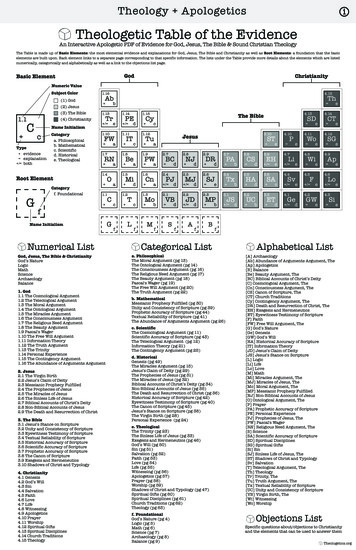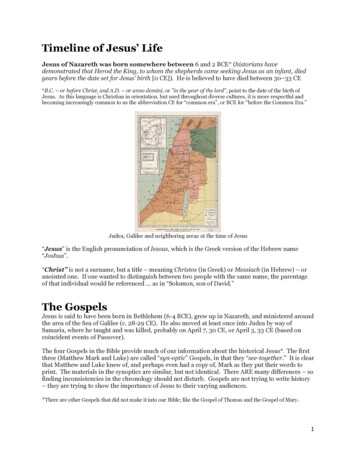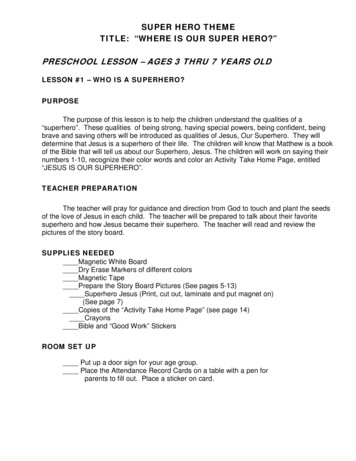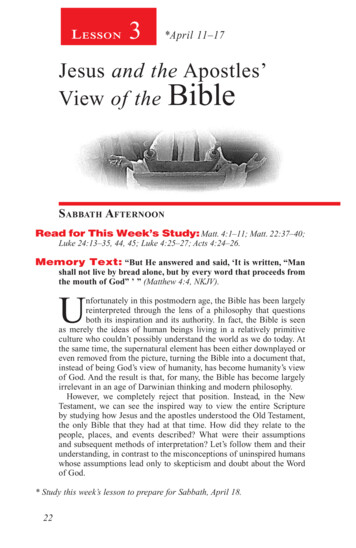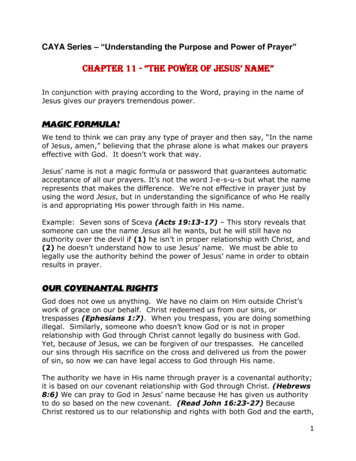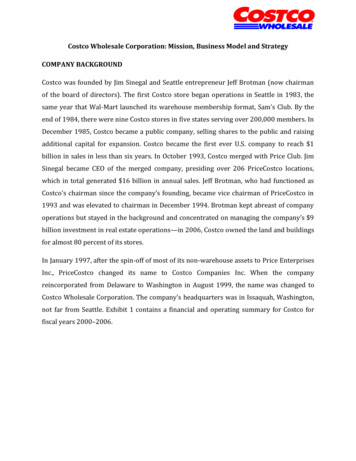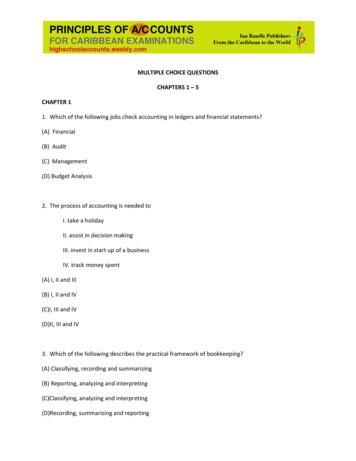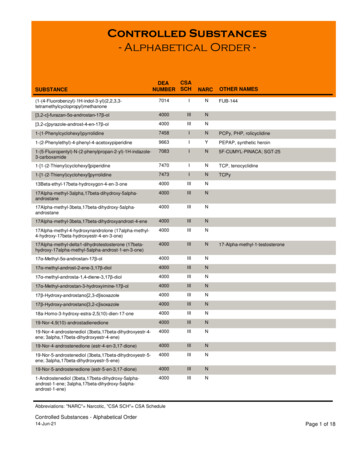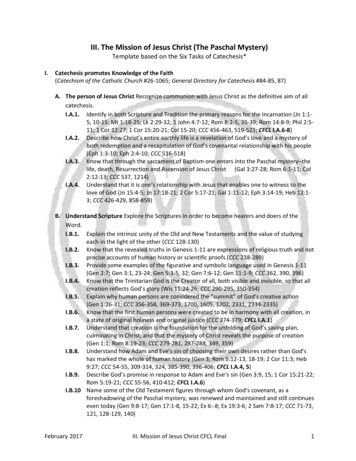
Transcription
III. The Mission of Jesus Christ (The Paschal Mystery)Template based on the Six Tasks of Catechesis*I.Catechesis promotes Knowledge of the Faith(Catechism of the Catholic Church #26-1065; General Directory for Catechesis #84-85, 87)A. The person of Jesus Christ Recognize communion with Jesus Christ as the definitive aim of allcatechesis.I.A.1. Identify in both Scripture and Tradition the primary reasons for the Incarnation (Jn 1:15, 10-15; Mt 1:18-25; Lk 2:29-32; 1 John 4:7-12; Rom 8:2-5, 35-39; Rom 14:8-9; Phil 2:511; 1 Cor 12:27; 1 Cor 15:20-21; Col 15-20; CCC 456-463, 519-521; CFCL I.A.6-8)I.A.2. Describe how Christ’s entire earthly life is a revelation of God’s love and a mystery ofboth redemption and a recapitulation of God’s covenantal relationship with his people(Eph 1:3-10; Eph 2:4-10; CCC 516-518)I.A.3. Know that through the sacrament of Baptism one enters into the Paschal mystery–thelife, death, Resurrection and Ascension of Jesus Christ (Gal 3:27-28; Rom 6:1-11; Col2:12-13; CCC 537, 1214)I.A.4. Understand that it is one’s relationship with Jesus that enables one to witness to thelove of God (Jn 15:4-5; Jn 17:18-21; 2 Cor 5:17-21; Gal 1:11-12; Eph 3:14-19; Heb 12:13; CCC 426-429, 858-859)B. Understand Scripture Explore the Scriptures in order to become hearers and doers of theWord.I.B.1. Explain the intrinsic unity of the Old and New Testaments and the value of studyingeach in the light of the other (CCC 128-130)I.B.2. Know that the revealed truths in Genesis 1-11 are expressions of religious truth and notprecise accounts of human history or scientific proofs (CCC 238-289)I.B.3. Provide some examples of the figurative and symbolic language used in Genesis 1-11(Gen 2:7; Gen 3:1, 23-24; Gen 5:3-5, 32; Gen 7:6-12; Gen 11:1-9; CCC 362, 390, 396)I.B.4. Know that the Trinitarian God is the Creator of all, both visible and invisible, so that allcreation reflects God’s glory (Wis 11:24-26; CCC 290-295, 350-354)I.B.5. Explain why human persons are considered the “summit” of God’s creative action(Gen 1:26-31; CCC 356-358, 369-373, 1700, 1605, 1702, 2331, 2334-2335)I.B.6. Know that the first human persons were created to be in harmony with all creation, ina state of original holiness and original justice (CCC 374-379; CFCL I.A.1)I.B.7. Understand that creation is the foundation for the unfolding of God’s saving plan,culminating in Christ; and that the mystery of Christ reveals the purpose of creation(Gen 1:1; Rom 8:19-23; CCC 279-281, 287-288, 349, 359)I.B.8. Understand how Adam and Eve’s sin of choosing their own desires rather than God’shas marked the whole of human history (Gen 3; Rom 5:12-13, 18-19; 2 Cor 11:3; Heb9:27; CCC 54-55, 309-314, 324, 385-390, 396-406; CFCL I.A.4, 5)I.B.9. Describe God’s promise in response to Adam and Eve’s sin (Gen 3:9, 15; 1 Cor 15:21-22;Rom 5:19-21; CCC 55-56, 410-412; CFCL I.A.6)I.B.10 Name some of the Old Testament figures through whom God’s covenant, as aforeshadowing of the Paschal mystery, was renewed and maintained and still continueseven today (Gen 9:8-17; Gen 17:1-8, 15-22; Ex 6:-8; Ex 19:3-6; 2 Sam 7:8-17; CCC 71-73,121, 128-129, 140)February 2017III. Mission of Jesus Christ CFCL Final1
I.B.11. Explain the term, “covenant” and how it is different from a contract (a covenant is asolemn, reciprocal relationship [Hebrew, berith] between two or more parties; acontract is simply a legally binding agreement, see G. O’Collins & E. Farrugia. A ConciseDictionary of Theology. Paulist Press, 2000)I.B.12. Know that God’s promise of redemption is fulfilled in the person of Jesus, through hisPaschal mystery–his life, suffering, death, Resurrection and Ascension(Gal 4:4-5; Rom 5:12-21; CCC 422-424, 452, 484; CFCL I.A.7)I.B.13. Give examples of the gradual unfolding of God’s promise of redemption in the gospelaccounts of Jesus’ earthly life (e.g., Lk 3:21-22; Lk 4:1-22; Jn 2:1-11; Mk 1:14-15; Mt17:1-13; Mk 10:45; Mt 14:22-32; Mt 15:29-31; Lk 7:11-17; Jn 4:25-26; Jn 7:37-39; Jn11:38-44; Jn 14:15-21; Mt 26:26-30; Jn 20:11-21; Lk 24:13-35)I.B.14. Understand that Christ’s entire life was a mystery of redemption (1 Jn 4:9; Eph 1:7; Col1:13-14; 1 Pet 1:18-19; CCC 516-518, 535-550, 554-561, 565-570)I.B.15. Describe our participation in Christ’s redemptive suffering (Rom 3:23; Mt 25:42-46; 1Cor 15:3-4; Mt 20:28; Heb 6:4- 6; Acts 9:4-5; CCC 597-598; 605-607; 613-614; 619-623)I.B.16. Explain the meaning of the kenosis, Christ’s pouring out of his life in love, as describedby St. Paul in Philippians 2:5-11I.B.17. Understand that, in the Resurrection of Jesus, redemption is accomplished and God’spromise is fulfilled (Phil 2:5-11; Lk 24:5-6, 33-49; Jn 20:11-18; Acts 10:36-43; 1 Cor 15:37; CCC 631, 638; CFCL I.A.8)I.B.18. Know that the Resurrection of Christ is not simply a resuscitation, or return to earthlylife, as was the raising of Lazarus or the widow’s son (1 Cor 15:35-44; 2 Cor 5:17; Lk24:30-33; Jn 20:14-17, 27-28; Jn 21:4-7; CCC 646-650)I.B.19. Identify some ways in which Christ’s Resurrection fulfills the past, sheds meaning onthe present and gives a foretaste of the future (1 Cor 15:14; Jn 8:28; Acts 13:32-34; Mk16:7; Lk 24:6-7, 26-28, 44-48; CCC 651-653, 655)I.B.20. Recognize the two great accomplishments of the Paschal mystery: Christ’s death freesall peoples from sin; Christ’s Resurrection opens the way to new life (Rom 4:24-25;Rom 6:4; Eph 2:1-10; 1 Pet 1:3; CCC 654, 1019, 1708; CFCL I.A.8-9)I.B.21. Know that the Ascension marks the entrance of Jesus’ humanity into heaven (Mt 28:1620; Mk 16:9; Acts 1:6-12; CCC 659)C. Creeds and Doctrines of the Church Become familiar with the great teachings of Christianityand their place in the priority of truths, e.g., the mystery of God and the Trinity, Christ, theChurch, the sacraments, human life and ethical principles, eschatological realities, and othercontemporary themes in religion and moralityI.C.1. Understand the Paschal mystery as one inseparable event encompassing the life, death,Resurrection and Ascension of JesusI.C.2. Explain why the Church’s teaching on the Incarnation is essential to understanding theredemption of humankind through the Paschal mystery of Christ (Heb 2:14-15; Col 1:22;2 Cor 8:9; 1 Cor 15:3-5; CCC 457-461, 483, 512, 517-518)I.C.3. Know that the full meaning of the doctrine of Original Sin is revealed only in light of thePaschal mystery of Jesus (CCC 385-389, 407, 415-421; CFCL I.A.5-7)I.C.4. Understand the significance of Christ’s Resurrection as both a historical, physical eventand a transcendent event beyond time and space that is at the heart of the Paschalmystery (CCC 638-640, 643-646, 656)February 2017III. Mission of Jesus Christ CFCL Final2
I.C.5.I.C.6.I.C.7.I.C.8.Describe the relationship between Christ’s Resurrection and the Church’s teaching onthe resurrection of the dead at the end of time (1 Cor 15:12-22; CCC 654-655, 658)Know that the final judgment reveals the fullness of God’s plan for eternal life for allwho are joined in Christ and have “passed over” from death to life in him, through hisPaschal mystery (CCC 1019-1044)Recognize that in the liturgical and sacramental life of the Church, and especially in theEucharist, the Paschal mystery of Christ continues to be celebrated–but not repeated(CCC 1067, 1104)Explain the Church’s teaching on the Assumption of Mary in light of her relationship toher Son in his Paschal mystery (Jn 19:26-27; CCC 964-966, 974)D. Discover the Church’s tradition and relevance of church history Learn the richness of theChurch’s tradition, explore the theological and cultural heritage in which faith is expressed, andgain perspective on contemporary events and trends through an understanding of churchhistory.I.D.1. Understand the significance of family stories in passing on life and wisdom throughgenerations, and that just as people tell the stories of their families, so the Church hasan important story, that of the Paschal Mystery, to tell through generations of believers(Hughes, Kevin L. Church History: Faith Handed On, in NCCL series, “Catholic Basics: APastoral Ministry Series,” Chicago: Loyola Press, 2002, pp. x-xv)I.D.2. Identify some of the early church councils that developed and determined the teachingon Jesus as both truly God and truly human and thus able to fulfill God’s promise ofredemption (CCC 464-469, 475-478)E. Christian thought and culture Develop the philosophical and theological foundations of thefaith and appreciate expressions of Christian thought and culture.I.E.1. Know that the term “mystery” comes from the Greek mysterion, a “secret” which inChristian thought becomes God’s loving plan for redemption as revealed in Christ (Eph1:9-10, 3:9-11; Rom 16:25-27; Col 1:26-27, 2:2-3, 4:3; see also “Mystery” in O’Collins,Gerald, SJ & Edward Farrugia, SJ. A Concise Dictionary of Theology, rev. ed. Mahwah NJ:Paulist Press, 2000, pp. 158-169)I.E.2. Understand the term “paschal” as coming from the Hebrew, pesach, or “passover,” andthe Greek, pasch, also referring to the Passover of the Jews and then, in Christianthought, the pass-over of Christ in his death, Resurrection and Ascension (1 Cor 5:7,11:23-26; Rom 6:3-4; CCC 542; see also A Concise Dictionary of Theology, p. 191)I.E.3. Identify some Christ-like figures in literature (figures who offer their lives for others),e.g., Santiago in Ernest Hemingway’s The Old Man and the Sea; Owen Meany in JohnIrving’s A Prayer for Owen Meany; Krishna in Margaret Atwood’s A Handmaid’s Tale;Don Quixote in Miguel Cervantes’ Don Quixote; Prince Myshkin in Fyodor Dostoevsky’sThe Idiot; Billy Budd in Herman Melville’s Billy Budd; Hazel in Richard Adams’ WatershipDown; the priest in Georges Bernanos’ Diary of a Country Priest; Simon in WilliamGolding’s Lord of the Flies, etc.I.E.4. Identify some Christ-figures in film, e.g., Gandalf and Frodo in Tolkien’s “Lord of theRings;” Mufasa in “The Lion King;” Randle McMurphy in “One Flew over the Cuckoo’sNest;” Luke Jackson in “Cool Hand Luke;: Andy Dufresne in “The ShawshankRedemption;” John Coffey in “The Green Mile;” Edward in “Edward Scissorhands;”Babette in “Babette’s Feast,” etc.February 2017III. Mission of Jesus Christ CFCL Final3
II. Catechesis promotes knowledge of the meaning of the Liturgy and Sacraments(CCC #1066-1690; GDC #84-85, 87)A. Paschal Mystery Forms and Transforms Understand, live and bear witness to the paschalmystery – the life, death and resurrection of Jesus Christ–celebrated and communicatedthrough the sacramental life of the Church.II.A.1. Know that the “Paschal mystery” is foreshadowed in the Passover story (Ex 1-15) in theOld Testament, the story of the liberation of God’s people and the beginning of a newrelationship with GodII.A.2. Understand that the “mystery” of God lies in God’s plan for the liberation and salvationof all peoples (CCC 1066, 759)II.A.3. Identify the “Paschal mystery” of Christ as God’s loving promise and plan ofredemption visibly carried out and fulfilled in the life, death, Resurrection andAscension—the “pass-over”–of Jesus the Christ (Eph 1:9-10, 3:9-11; 1 Cor 5:7, 11:2326; Rom 6:3-4, 16:25-27; CCC 388, 421, 571, 638, 1067-1068, 1085; LG 3 [LumenGentium, Vatican II]; see also SC 5 [Sacrosanctum Concilium, Vatican II])II.A.4. Know that Christ’s Paschal mystery continues to be celebrated (but not repeated) inthe liturgical and sacramental life of the Church, especially in the celebration of theEucharist (CCC 1067, 1104)II.A.5. Understand that those who take part in the liturgical and sacramental life of theChurch also take part in the mystery of life in Christ and of redemption through him—the Paschal mystery (Gal 2:19b-20; Eph 2:4-6; Col 3:3-4; CCC 1066-1068)II.A.6. Explain how the Paschal mystery of Christ is not merely a one-time event in the pastbut continues to be present to the faithful in the present (CCC 1085)II.A.7. Know that it is through participation in the liturgy and sacraments of the Church thatwe are formed and transformed in Christ (Jn 1:29b; Jn 12:32; Rom 6:4-6; Rom 12:5; 1Cor 12:13, 27; 2 Cor 5:17; Eph 4:15-16; Phil 3:20-21; Col 2:12; CCC 562, 1074, 1694; Heb12:1-3; LG 7)B. Sacraments Learn and embrace in one’s life church doctrine on the eucharist and othersacraments.II.B.1. Know that the mysteries of Christ’s life announced and prepared the way for thesacraments of the Church (CCC 1114-1116)II.B.2. Explain how, in the sacraments, Christ is acting in his Church through the power of theHoly Spirit (CCC 1116)II.B.3. Identify Baptism as the sacrament by which a person enters into the Paschal mystery ofJesus (Gal 3:27-28; Rom 6:1-11; Col 2:12-13; CCC 537, 628, 1214, 1694)II.B.4. Identify the Eucharist as the sacrament through which Christ both signifies and makespresent his Paschal mystery in the life of the Church (CCC 610-611, 1085)C. Liturgical Catechesis Acquire the spirituality, skills and habits of full, conscious, and activeparticipation in the liturgy, especially the eucharistic liturgy.II.C.1. Understand and be able to define the term, “liturgy” (CCC 1069-1072)II.C.2. Know that in the liturgy the Church celebrates, above all else, the Paschal mystery bywhich Christ accomplishes the work of salvation (CCC 1067; Eph 3:4, 9)February 2017III. Mission of Jesus Christ CFCL Final4
II.C.3. Understand that the cycle of feasts throughout the liturgical year unfolds the Paschalmystery, which in its many aspects is one continuous act of God’s redeeming love (CCC1171, 1193-1195)II.C.4. Recognize that, in the liturgy, the faithful directly encounter Christ in his Paschalmystery (CCC 1074, 426)II.C.5. Explain why the liturgy is considered a “privileged place” for the catechesis of God’speople (CCC 426-429, 1694-1698; SC 10; see also National Directory for Catechesis, #20:Since Christ is present in the sacraments, the believer comes to know Christ in theliturgical celebrations of the Church and is drawn into communion withhim Catechesis should promote “an active, conscious genuine participation in theliturgy of the Church” [NDC 20])D. Dimensions of Priesthood: Baptismal and Ordained Value the dignity of the baptismalpriesthood and of the ordained priesthood and value their respective roles in liturgicalcelebration and Christian mission.II.D.1. Understand that the liturgy is celebrated by the whole community, the entire Body ofChrist, and therefore is not a “private” prayer or function (CCC 1136, 1140, 1187; 1 Pet2:5, 9)II.D.2. Know that within the Body of Christ there are different and specific roles or functionsamong persons in the celebration of the liturgy (CCC 1141-1144, 1188)II.D.3. Distinguish between the common priesthood of all the baptized and the ordainedpriesthood (CCC 1141-1142)III. Catechesis promotes Moral Formation in Jesus Christ(CCC #1691-2557; GDC #84-85, 87)A. Commandment to Love Understand how the entire law of the Gospel is contained in the ‘newcommandment’ of Jesus, to love one another as he has loved us.III.A.1. Know that by Baptism into Christ’s life–into his Paschal mystery–a person becomesresponsible for growing both in personal holiness and in service to others, i.e., forgrowing in love (CCC 520-521, 562, 1694 2028; Phil 2:5; Jn 13:15)III.A.2. Identify some relevant aspects of Christ’s Paschal mystery inherent in his command tolove one another as he has loved us, e.g., desire for unity; ready to be at the service ofothers; specifically caring for the poor; unafraid to suffer for another person, even anenemy; willing to die, for another person to have life; etc. (CCC 1825)III.A.3. Locate the Old Testament sources for the ‘new commandment’ of Jesus (Deut 6:4-6;Lev 19:18; cf. Lk 10:25-28)III.A.4. Explain why St. Paul calls love “the fulfillment of the law” (Rom 13:8-10; see 1 Jn 4:18;CCC 1823-1824, 1970, 2055)B. Ten Commandments and Beatitudes Study the Ten Commandments, the Beatitudes, and themoral catechesis of the apostolic teachings, and live in accord with them.III.B.1. Know that in his life and teachings, Jesus faithfully followed the Old Law of his Jewishfaith and, through his Paschal mystery, both fulfilled and surpassed it (Mt 5:17-18; CCC1967-1968)February 2017III. Mission of Jesus Christ CFCL Final5
III.B.2. Understand that the Ten Commandments (from the Old Law) are still valid moralnorms for living as a disciple of Jesus (CCC 1962-1964)III.B.3. Identify some specific ways in the Sermon on the Mount that Jesus’ New Law of theGospel goes beyond the Old Law (Mt 5; see Lk 6:20-36; CCC 1968, 1972, 1983-1985,2054)III.B.4. Explain the significance of the Beatitudes for one who has been baptized into thePaschal mystery of Christ (Gal 3:27; CCC 1716-1717)C. Sin and Grace Understand the reality and nature of sin and the power of God’s grace toovercome it.III.C.1. Recognize sin as the disruption of the relationship between God and his people, withwhom he desires to share eternal life and happiness (CCC 1691-1696; CFCL I.A.4)III.C.2. Know that the sin of Adam and Eve’s choice to break their relationship with God, whichfrom that day forward would mark all of human history, was the occasion of God’sinitial promise of redemption (Gen 3:15; Gal 3:19, 4:4; CCC 388-390, 1850; CFCLI.A.4, 6)III.C.3. Understand that the church’s teaching on Original Sin is best understood in light ofChrist’s Paschal mystery—the fulfillment of God’s promise of redemption (CCC 389,402-411, 415-421; Rom 5:12, 17, 19)III.C.4. Know that the Paschal mystery of Christ brings the light of redemptive grace to themystery of evil and the reality of sin in the world (CCC 309-314, 324; Rom 5:15-18,8:10-11)III.C.5. Know that God’s grace has the power to overcome sin and evil (Rom 5:20-21)III.C.6. Understand that the grace of the Holy Spirit comes to us through our baptism into thePaschal mystery of Christ (Rom 6:8-11; CCC 1987-1997)III.C.7. Realize that, while God offers the grace of redemption, it is the responsibility of theindividual person to accept it and to grow in living a virtuous lifeIII.C.8. Know that one’s acceptance or refusal of God’s grace and love will be revealed at thetime of the Last Day (Mt 25:40, 45-46; Jn 5:27-29; CCC 678-679, 682)III.C.9. Understand that our bodily death is a consequence of sin (CCC 1007-1008, 1018)III.C.10. Know that Christ, through the Paschal mystery of his death and Resurrection, hasovercome death and opened to all the possibility of salvation (CCC 1009, 1019, 1026; 1Cor 15:26, 42-44)III.C.11. Know that we who “die in Christ” sacramentally–as we are baptized into his Paschalmystery–and die bodily in his grace, shall also rise with Christ as we are completelyincorporated into his redeeming act (2 Tim 2:11; Phil 1:23; CCC 1010-1014)III.C.12. Explain our Christian belief in the resurrection of the body (Jn 5:28-29; Phil 3:21; 1 Cor15:20-24, 35-38, 42, 51-56; CCC 994-1005)III.C.13. Distinguish between the particular, or immediate, judgment at one’s death and theLast Judgment at the end of time (Lk 16:22-23, 23:42-43; Heb 9:27-28; CCC 1021-1022;2 Cor 5:10; Jn 5:28-29; Acts 24:15; Mt 25:31-32, 46; CCC 677-682, 1038-1039)III.C.14. Know the Church’s teaching on Heaven (CCC 1023-1029); Hell (CCC 1033-1037); andPurgatory (CCC 1030-1032)D. Conscience Formation Learn how to acquire and follow a well-formed conscience in personaland social life, clarifying current religious and moral questions in the light of faith, andFebruary 2017III. Mission of Jesus Christ CFCL Final6
cultivating a Christian discernment of the ethical implications of developments in the sociocultural order.III.D.1. Explain what it means, to say that human beings are “created in the image of God”(Gen 1:27; 2 Cor 4:4; Col 1:15; CCC 1701-1705, 1710-1712; CFCL I.A.1-2)III.D.2. Recognize that the moral law is implanted in our hearts by the God in whose image weare created (CCC 1702-1706)III.D.3. Know the meaning and the role of “conscience” (CCC 1776-1778)III.D.4. Identify some of the elements crucial to the development of an informed conscience(CCC 1783-1785)III.D.5. Understand that the human person has the freedom either to choose what is good orto turn away from it (CCC 1706-1707)III.D.6. Know that one is strengthened and empowered to seek and choose what is good,guided both by God’s grace and by the power of the Holy Spirit acting in one’s life (CCC1704, 1709, 1711, 1997)III.D.7. Understand that through his Paschal mystery, Christ restores our wounded humannature and opens to us a new life in the Holy Spirit(CCC 1699, 1708, 1715, 1999;CFCL I.A.8-10)E. Objective Moral Norms Recognize, defend, and live by the truth of objective moral norms astaught by the Church’s magisterium in its moral and social teaching.III.E.1. Know that all law finds its first and ultimate truth in the eternal moral law establishedby God (CCC 1950-1951)III.E.2. Identify the several different but interrelated expressions of the moral law (CCC 1952)III.E.3. Understand that the natural law, written in the heart of each human being, expressesthe original, God-given ability of the person to discern good and evil (CCC 1954)III.E.4. Know that the Ten Commandments, or Decalogue, of the Old Testament express thebasic principles of the natural law (CCC 1955; see Ex 31:18, 20:1-17)III.E.5. Understand that the natural law provides objective norms which are the foundationfor all moral and civil law as taught by the Church’s Magisterium (CCC 1955-1960)III.E.6. Know that, while the application of the natural law may vary with the time and theculture, the basic, objective norms remain constant (CCC 1957-1958)III.E.7. Know that it is in the person of Jesus that the moral law finds its fullness and its unity(CCC 1953, 1965-1968, 2054-2055)F. Gospel of Life Promote a thorough catechesis on the Gospel of Life so that respect for life fromconception until natural death is honored in personal behavior, in public policy, and in theexpressed values and attitudes of our society.III.F.1. Know that every human being is created in God’s image and every human life is sacred,from conception to natural death (CCC 2258, 2258-2262, 2270, 2277, 2319, 2320-2324,1701; CFCL I.A.1)III.F.2. Understand that baptism into Christ and his Paschal mystery calls us to choose his wayof love and life (CCC 1693-1696; Jn 14:6; Rom 6:5, 11; Phil 2:5; Eph 5:1-2; Col 2:12)February 2017III. Mission of Jesus Christ CFCL Final7
G. Living a Moral Life Live a lifestyle reflecting scriptural values of holiness, simplicity, andcompassion.III.G.1. Understand that by baptism into Christ, one is called to a life of holiness and service (1Thes 4:7; Gal 3:27; CCC 1694, 2013, 2017, 2028, 2045-2046, 2813)III.G.2. Know that in the mysteries of his life, Jesus Christ is the model of holiness (CCC 459; Mt5:43-48, 11:29; Mk 8:34-35; Jn 15:12-14; Jn 14:6; CFCL I.A.10-11)III.G.3. Understand that one grows in holiness in and through Christ’s Body, the Church(CCC 823-825, 1248, 2014, 2030-2031, 2045-2048)III.G.4. Identify some essential characteristics of a person growing in holiness, e.g., Mt 5:44,48; Mt 6:1-6; Mt 7:12; Mt 19:21; Jn 13:35; CCC 1779, 2014-2015, 2443-2444III.G.5. Recognize the power of the Holy Spirit and the gift of God’s grace in one’s relationshipwith Jesus Christ as the sources which enable one to live a moral and holy life(CCC 1692, 1704, 1708-1709; CFCL I.A.17)IV. Catechesis Teaches the Christian how to Pray(CCC #2558-2865; GDC #84-85, 87)A. Christian Prayer Tradition Become familiar with the diverse forms and expressions of Christianprayer, with special attention to the Our Father, the prayer which Jesus taught his disciples andwhich is the model of all Christian prayer. Experience and appreciate the richness of theCatholic tradition of mysticism and contemplation as it has taken from across the centuries indiverse historical and cultural settings.IV.A.1. Know that Christian prayer must be rooted in our communion in Christ and in his Body,the Church (CCC 2564-2565)IV.A.2. Understand that, in prayer, God’s invitation to a loving encounter first comes to us andthen we respond, seeking to answer that call and receive the gift of prayer (CCC 2558,2566-2567)IV.A.3. Describe the central role of prayer in developing intimacy and communion with Jesus inthe life of a disciple (CCC 2560-2561; Jn 4:1-30; Jn 15:1-5)IV.A.4. Identify some figures in the Scriptures who model prayer and teach us about it, e.g.,the psalms of King David; Solomon in 1 Kings 3:5-15; Mordecai & Esther in Est C; Job inJob 42:1-6; Mary in Lk 1:46-55; Jesus in Lk 6:12, 9:28, 11:5-13, 18:9-14, 22:39-46; andJesus in Mt 6:9-14, Lk 11:1-4; (CCC 2590-2598)IV.A.5. Know that Scripture, the word of God, is a rich source and reliable guide for prayer; andidentify some familiar prayers with scriptural roots, e.g., the Lord’s Prayer/Our Father;the Hail Mary; canticles and psalms in the Mass and Liturgy of Hours, etc.IV.A.6. Recognize in Jesus a model of prayer for his disciples (Mk 1:35, 6:46; Lk 2:49-52, 3:21,5:16, 9:28; Lk 11:1-13; Lk 22:32, 39-46; Lk 23:34, 46; Jn 11:41-42, 16:24; Jn 17; CCC2599-2605; 2607-2616)IV.A.7. Explain how the Lord’s Prayer is fundamental to the Church’s understanding of thenature and value of prayer (CCC 2759-2761)B. Personal Prayer Develop a regular pattern of personal prayer and spiritual reflection,recognizing vocal prayer, meditation, and contemplative prayer as basic and fruitful practices inthe life of a disciple of Jesus.February 2017III. Mission of Jesus Christ CFCL Final8
IV.B.1. Explain why prayer is an essential aspect of the life of a disciple (Jn 15:4-5; Lk 11:9-10;Mk 9:25-29)IV.B.2. Know that God calls every individual to a vital relationship with him, a relationship thatis rooted, nurtured and experienced in prayer (Rom 6:5; Eph 3:14-21; CCC 2591, 2560,2564-2565)IV.B.3. Value and develop a personal discipline of prayer as a means for growing in intimacyand communion with Jesus Christ (GDC 80-81; NDC 19B; CCC 2560, 2564-2567)IV.B.4. Identify some ways that vocal prayer, meditation and contemplative prayer nurtureand sustain the life of a disciple of Jesus (CCC 2722-2724, 2701-2712, 2705-2706, 2709,2712)IV.B.5. Describe the place of prayers of blessing, adoration, petition, intercession,thanksgiving, and praise (CCC 2626-2628, 2631-2633, 2634-2635, 2637-2639, 26442649)C. Communal Prayer In addition to the Eucharistic liturgy, learn to appreciate the Liturgy of theHours and engage in shared prayer with others, especially family prayer, as well as at parishmeetings and in small communities of faith.IV.C.1. Identify some of the means by which the Church invites the faithful to regular,communal prayer as the Body of Christ (CCC 2720)IV.C.2. Understand that each celebration of the Eucharist is a proclamation of the Paschalmystery of Christ (CCC 1344)IV.C.3. Know that the Eucharist both contains and expresses all forms of prayer (CCC 2643)IV.C.4. Explain how living a life of prayer, worship and service in a communal setting canprovide greater opportunities to live the Paschal mystery of Jesus (CCC 562, 914-916,1816, 1823, 1986, 2346-2347, 2443-2447)D. Popular Piety and Devotions Recognize and encourage practices of popular piety and devotionthat help believers express and strengthen their faith in Jesus Christ.IV.D.1. Recognize that, in addition to hearing God’s Word and sharing in the Paschal mystery,disciples receive many opportunities from the Holy Spirit to respond in prayer to theevents of daily life (CCC 2659-2660)IV.D.2. Know that personal and liturgical prayer is expanded and strengthened throughdevotional prayer, e.g., devotion to the Sacred Heart of Jesus, the Rosary, variouslitanies, the Way of the Cross, etc.IV.D.3. Identify some ethnic/cultural devotions that support the faith of believers, e.g., thePosadas, the Jesus Prayer, various Marian devotions, etc.V. Catechesis prepares the Christian to live in Community and to participate in the life and missionof the Church(GDC #84, 86-87) Heb 12:1-3A. Spiritual Growth Pursue personal and spiritual growth in human and Christian maturity.V.A.1. Understand that Christ’s whole earthly life—words, deeds, silences, sufferings—was aprocess of growing into the Paschal mystery of his life, death and resurrection (CCC516-518)February 2017III. Mission of Jesus Christ CFCL Final9
V.A.2. Know that a disciple of Jesus, baptized into his Paschal mystery, is called to follow himby growing in a life of holiness and service (Rom 1:11-12; Rom 6:3-5; Rom 8:14-17; CCC459-460, 537, 542, 2045-2046; CFCL I.A.12)B. Relationships and Responsibilities Cultivate the human values and Christian virtues that fostergrowth in interpersonal relationships and in civic responsibility.V.B.1. Identify some of the values and virtues in one’s behavior toward others that are signsof the disciple’s growth in Christ (2 Pet 1:3-8; 1 Pet 3:8-12; Jas 3:17-18; Jas 4:11; 1 Jn3:16-18; 1 Tim 6:11; 1 Thes 5:11-22; 1 Thes 4:3-8; Col 3:12-17; Phil 2:1-4; Eph 4:25-5:5)V.B.2. Explain how one’s participation in the Paschal mystery demands charity and justicetoward others, on both the personal and civic levels of relationship and responsibilities(Mt 25:31-46; CCC 1397; 2443-2448; 1905-1916; 1924-1927)C. Marriage and Family life—Domestic Church Nurture marriage and family life to build up theChurch of the home.V.C.1. Explain how the Christian family, as a “communion of persons,” is a “sign and image” ofthe life of the Holy Trinity (CCC 2205; 2250; CFCL I.A.3)V.C.2. Identify the specific attributes of Christ that should mark the members of the Christianfamily as participants in his Paschal mystery (CCC 2205; 2251-2253)D. Faith Communities Share actively in the life and work of the parish, and foster the potential ofsmall communities to deepen the faith and relationships of members, to strengthen the bondsof communion with the parish, and to serve the Church’s mission in society.V.D.1. Understand that, beginning with one’s family, one’s parish and finally the universalChurch, baptism into the Paschal mystery of Christ draws one ever deeper intocommunion at all levels with God and with others (CCC 752)E. Nature and m
Know that the revealed truths in Genesis 1-11 are expressions of religious truth and not precise accounts of human history or scientific proofs (CCC 238-289) I.B.3. Provide some examples of the figurative and symbolic language used in Genesis 1-11 (Gen 2:7; Gen 3:1, 23-24; Gen 5:3-5, 32; Gen 7:6-1
